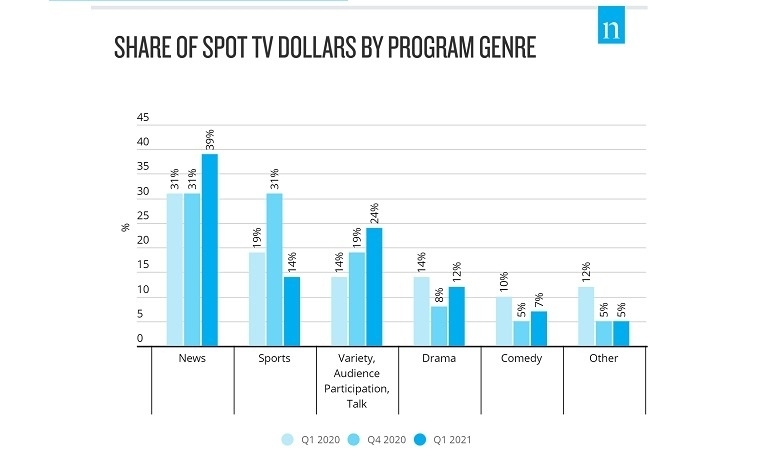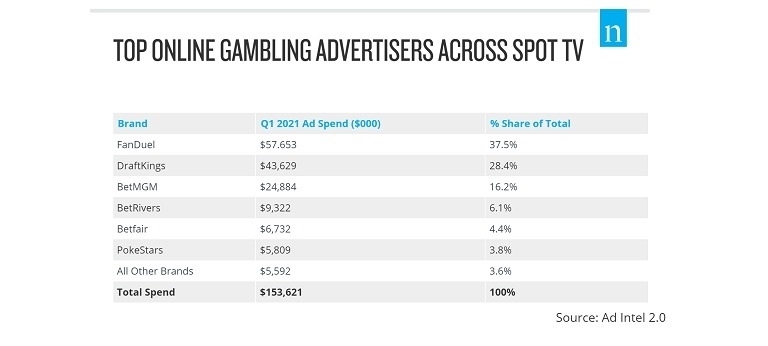

The company maintains this as a likely forecast, given current trends and the expected addition of sports betting in a handful of states where legislation is pending. This is good news for the local TV market, which accounts for just under 80% of online gambling ads.
Forecasts aside, the increase in online gambling ads has been a boon for local TV stations, particularly as many traditional advertisers pulled back or paused in 2020 due to the COVID-19 pandemic. According to Nielsen Ad Intel data released in the March Nielsen Total Audience report, U.S. TV advertising dropped to just over US$76 billion last year from just over US$84 billion in 2019, with the retail (-22%), auto (-17%) and restaurant (-8%) categories pulling back notably.
Given the sports betting focus of the top advertisers, sports programming is a key way to reach sports bettors. Surprisingly, the largest share of online sports betting ads is currently allocated to news programming. One reason attributable to this fact is that local news stations have much more control over their total ad inventory (versus sports programming which typically occurs in primetime), and as a result, there is more flexibility to place ads in news. It’s also worth noting that the share of these ads in news programming has increased to almost 40% over the past year. The increase isn’t without its merits, as news offers significant reach and an opportunity to engage new spenders, growing the consumer base.

While sports programming still has the biggest reach (77%) of the country’s sports bettors, local news currently reaches just over half (53%) and growing. Other categories representing possible opportunities for brands seeking greater targeted audience reach for sports bettors include movies and comedy programming, with reach of 76% and 74%, respectively.
Given the ramp-up in spending since 2019, online gambling now ranks 11th among 1,200 product categories for spot TV advertising dollars, accounting for 2.1% share. Comparatively, legal services, the top category for dollars spent, accounts for 7%.
As with any marketing effort, especially when the goal is brand building, extensive messaging across mass mediums amplifies top-of-mind awareness. And to that effect, the top seven advertisers in the online gambling space account for 96% of the spot TV ads in the category. What’s more, the top three are the most prolific spenders, accounting for 82%.
Among the top three spenders, FanDuel and DraftKings focus exclusively on sports betting. Their ad campaigns are prolific and produced to specifically appeal to the country’s rabid sports bettors. The targeting is spot on, as the 7.3 million daily fantasy bettors in the U.S. have an aggregate income of more than $780 billion, according to data from Nielsen Scarborough. Additionally, the new online sports bettor is younger than other bettors (live sports bettors at casinos, cash bettors at sporting events, organized fantasy league players) and is mostly male (77%).

In addition to revised federal regulations allowing advertised sports betting on TV, professional sports leagues themselves have increasingly warmed up to the idea as well. Today, NFL Commissioner Roger Goddell says sports betting creates more engagement with fans, which is a notably different perspective from back in 2012 when he expressed concerns about possible collusion and fixed games. Some sports teams, such as the New York Giants and Washington Wizards, have physical sports books inside their stadiums. And when it comes to TV, sports broadcasts no longer hedge when it comes to talking about game odds and spreads. In fact, some programming even features on-screen tickers detailing point spreads as the action unfolds.
The overwhelming sea change across the sports and media industries with respect to betting ads highlights a significant growth opportunity for both local and national television. In 2020, online/digital sports betting-related ad spend increased across 180 of the 208 designated market areas (DMAs) that Nielsen monitors. Additionally, online/digital sports betting spend in 185 DMAs exceeded US$300,000, up from less than US$50,000 across those same DMAs in 2017. So even though gambling activities are limited to select states, advertising in this category, where legal, is increasing across the overwhelming majority of the country’s 208 DMAs. And that spells opportunity for local news organizations and advertising agencies alike.
Source: Nielsen